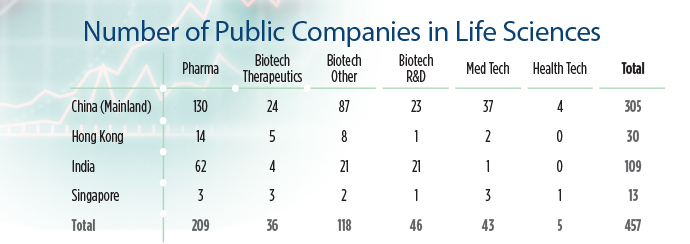Following on its Site Selection for Life Sciences Companies in Europe series, KPMG in July published “Site Selection for Life Sciences Companies in Asia.”
Focused on on the fast-growing markets of India, China, Hong Kong SAR and Singapore, the 62-page report also includes overviews of Indonesia, Malaysia, the Philippines, Thailand and Vietnam, and shares specialist insights into three areas: the IPO landscape; a comparison of the clinical trial environments in China and the U.S.; and the digitalization of the healthcare industry.
Below is an adapted excerpt of the section on the IPO landscape by Patrik Frei, CEO of Venture Valuation, whose business development database Biotechgate profiles more than 50,000 life sciences companies and over 80,000 potential licensing assets worldwide. Even as companies consider supply chain diversification away from China after the COVID-19 pandemic, it offers insights into the still-promising market and business landscape there. For the full report, visit home.kpmg/ch/en/home/insights/2020/07/site-selection-for-life-sciences-companies-in-asia.html.
For this report, 457 publicly listed Life Sciences companies that are headquartered in China, Hong Kong SAR, India and Singapore have been analyzed. We found clear trends in companies’ choice of listing jurisdiction. But which sectors have carried out most IPOs over the past decade, and how are regulatory and other initiatives impacting where life sciences firms choose to list?
Of the 457 companies analyzed, activities are weighted heavily toward pharma and biotech. Medtech and healthtech make up the balance of around 10%, though there are signs this might be changing. Mainland China and India are home to more than 90% of public life sciences businesses. More biotech companies than pharma companies are listed in mainland China, while the opposite is the case in India.

A total of 196 listings raised a total of US$27.6 billion over the past 10 years. China took the lead out of the four jurisdictions noted, at 78.5% of all IPOs, and raised 87.7% of the capital. In Hong Kong, most IPOs were in biotech, reflecting the regulatory environment that allows pre-revenue companies to list on the Hong Kong Stock Exchange. In India, the public companies are predominantly generic or API manufacturers, as well as service-oriented businesses.
The most valuable IPO in India was carried out in 2015 by Alkem Laboratories, a manufacturer and seller of generics, formulations and neutraceuticals. Singapore’s status as one of the most fertile ecosystems for life sciences innovation and start-ups has not translated into a surge of listings … yet.
China and Biotech Surge, But India’s On the Rise Too
For the first time, there was no Life Sciences IPO in Singapore or India in 2019. While China extended its lead in IPOs, it has suffered its own interruptions to IPO activity in the past: Its banking liquidity crisis in 2018 led to the lowest number of IPOs in the region that year. And in 2015 it introduced a four-month suspension of IPOs to reverse a steep decline in stock prices.
In terms of individual stock exchanges, it was the Hong Kong Stock Exchange (HKEX) that dominated the IPO scene over the past five years. HKEX was followed by the Shenzhen Stock Exchange and the Shanghai Stock Exchange. However, the opening of the Nasdaq-style Shanghai Star Market may dent Hong Kong’s lead in biotech listings in particular, especially as dual listings are permitted in China.
Another factor may also support China’s biopharma industry: The National Medical Products Administration overhauled China’s regulatory environment. Together with the introduction of International Council for Harmonisation of Technical Requirements for Pharmaceuticals for Human Use (ICH) complaint guidelines as a result of China becoming a full member of the ICH in 2017, this has increased trust in the Chinese biopharma sector.
These trends helped China-based BeiGene to raise $903 million in Hong Kong’s first secondary listing under the new rules, for example.
Pharma has traditionally been the driving force behind listings of life sciences companies. Since 2018, however, with the overhaul of the regulatory environment, change in listing requirements for companies on the HKEX, and the opening of the Shanghai Star Board, the number and value of IPOs of biotechnology therapeutics & diagnostics firms has risen (from 13% in 2017 to 46% in 2018 and 47% in 2019).
A 2019 highlight was the FDA granting approval to a blood cancer drug from Beijing’s BeiGene Ltd. This paves the way for U.S. patients to access a Chinese cancer therapy for the first time.
China has the strongest pipeline, followed by India and Hong Kong. All countries have phase III projects except Singapore. India has a strong phase III pipeline compared to other phases in the country. Forty-four percent of pipeline products are at the pre-clinical stage, while 22% are at phase III. This indicates a significant increase in the value of Asian biotech companies could be in the cards.
China and Hong Kong are the clear front runners in life sciences listings, and look set to remain so for the foreseeable future. Regulatory and government initiatives in India in particular, however, may challenge this pre-eminence over time, especially as Indian companies move up the value chain.
